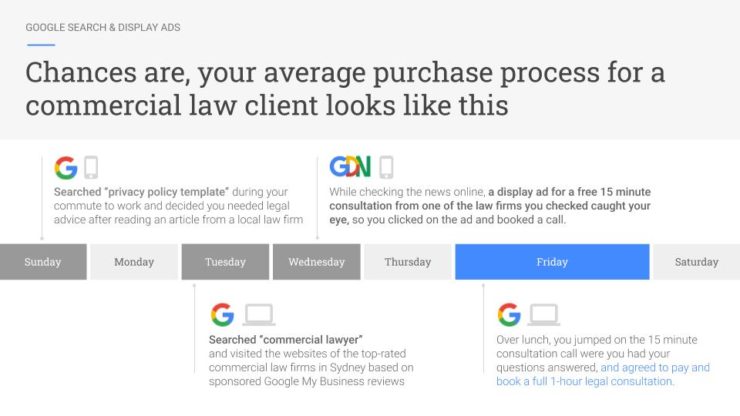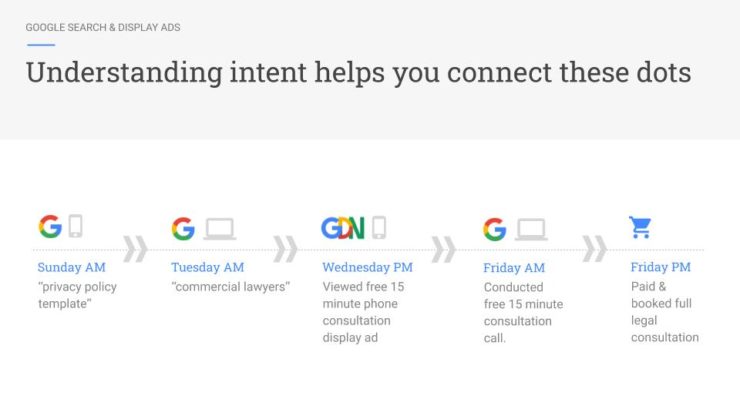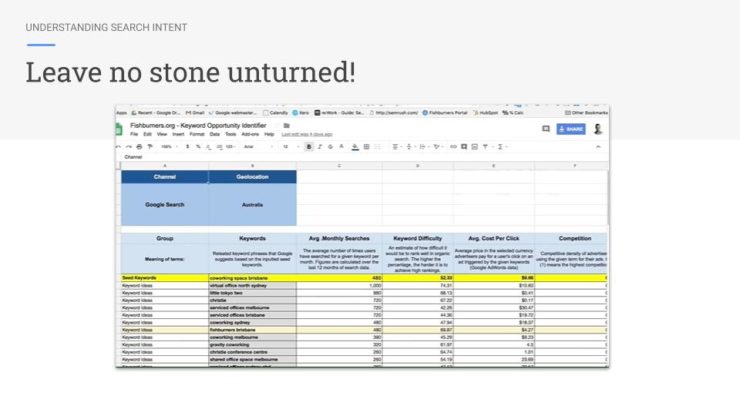Understanding your clients’ journey for your business is one of the most important things to get right and to get clear before you embark in any type of marketing or advertising campaign.
In this article, I’ll walk you through an example of a customer journey for a typical law firm: what it means, what it looks like and how that understanding can be leveraged to drive more interest and sales to your law firm.
Understand your ideal client online customer journey
One of the key things to get right with online marketing is understanding the joinery your ideal client takes before they end up choosing a firm to engage with. One question that can help you understand what this customer journey looks like for your firm is: what does your customer do and are they thinking before they decide to engage with a law firm or a lawyer?
Let’s look at a online customer journey example for a commercial law firm:

Let’s break this example down with a scenario:
- We’ve got a busy corporate CEO, it’s a Sunday and he is commuting up to the capital city for work.
- While he is commuting, he is searching for a privacy policy template on his phone as his brand new business vertical that he is building a new website for, needs a privacy policy.
- During his search, he discovers your article on your website that tells him why you should engage with a professional commercial law firm as opposed to just pulling a template of Docracy as an example.
- Armed with that new knowledge, he begins searching for a commercial lawyer in the local area.
- During the search, he is checking out what other people are saying about the law firm from their Google My Business listing so he can understand what are the top rated firms in his area.
- After doing a little bit of research, he gets distracted with work.
- Later in the week, he visits his favourite news site. While browsing the site, he sees a display ad offering a free 15-minutes consultation with one of the commercial law firms that he visited.
- This display ad captures his attention and reminds him that he needs to speak with a lawyer to get his privacy policy sorted.
- He decides to click on that ad which takes him to the firm’s landing page from where he goes ahead and books the free 15-minute call.
- The phone call happens over Friday lunch. He exits the call feeling convinced he has found the right firm for his needs. From there, he pays for that full one-hour legal consultation which leads to the full service being delivered and billed for off the back of that paid consultation.
We can use that understanding of a typical customer journey to build our search marketing campaign strategy, targeting, messages and offers around.
Understanding your customer’s search intent

Let’s break down that example above and examine how we can target the client at each step in the journey.
- The initial keywords we could target are keywords related to the search theme of privacy policy templates.
- With the potential client now educated by us, we start targetting them around service-orientated keywords such as ‘commercial lawyers near me’, etc.
- After the potential client has shown interest and has engaged with our 15-minute free consultation offer, but they haven’t signed up to it, we remarket the offer to them using the Google Display Platform. We typically remarket the offer for anywhere between 7-30 days depending on the buying cycle and habits of your ideal client.
- We helped solve their initial problem of simply having someone to speak to via a free 15-minute phone consultation.
- Now that we’ve established trust and have demonstrated expertise with the prospective client, we offer them an initial paid consultation followed by the full paid service.
Looking at this process from the top down, we can see how the intent of our ideal client changes as they move through the online journey. They seek for a solution in search. You educate them on why the solution they think they need is actually incorrect, and inform them on the actual solution they should be needing to better solve their problem.
Now that you’ve educated the prospective client, they are more inclined to engage with you as you have already exchanged value with them before you’ve even had the initial conversion.
You make it easy for them to engage you with a free-15 minute consultation which positions your firm as the one that can solve the ideal client’s problem the best.
You transition the prospect to a paying client with a low-resistance paid consultation offer.
You ascend the client to your full service on completion of the paid consultation.
By targeting and making separate offers based on your customer’s intent throughout that entire customer cycle, we can make sure they engage with and convert on the right offer at the right time.
Do you know what sources are actually delivering you clients?
Mike Bromley from Beyond Billables suggests that a lot of business owners across the board struggle to even articulate where their work comes from.
It’s really important as a first step to know what your sources of work are, who these clients are so that you can map these things out. Doing that work beforehand can inform you as to where your work is coming from and where you need to invest, especially around customer intent and what has worked for you in the past.
Any good marketing agency should start by what makes your firm different and appealing and what is the type of client you want to be bringing onboard. What’s is your target client’s pain points? Where do they go for information? What do they need to know to make buying decisions? What are the questions that keep them awake at night which you can answer?
Once you have that understanding, you can then go head and start building our your online customer journey which enables you to target your audience with specific and relevant offers at the right time and the right place until they convert into a client.
Specificty is just as important as intent.
Shouting out to the online masses “Hey! Here’s my contact page, contact me!” although you may get some enquiries, the conversion rate is significantly lower than a dedicated sales funnel offer which means you end up overpaying to acquire a new client. In some cases, relying on this type of strategy results in a conversion rate so low that it makes your entire marketing and advertising strategy fundamentally unprofitable.
How we fix that problem is by making relevant offers to the right audience on with the right search intent.
Keyword research can help you get into the mind of what your ideal client is searching for answers in Google

Keyword research is a critical component to get right before you embark on any search marketing campaign. In-depth keyword research can help you target the right keywords so you can align your ads and landing page offers with these keywords. It can also give you an insight into where consumer demand lies so you can use this data to help craft relevant offers based upon what your audience is searching for in Google.
The same applies with your content marketing. Certain keyword searches will only return articles in the search results as the customer intent is to get educated as opposed to engaging a service. For these type of keyword searches, you want to target with a well-written article that answers the question that your audience is searching for. If you want it to rank on the first page, then you need to make it better than your competitors who are already currently ranking for the keyword search phrase.
Splitting out your keyword research into service-based keywords that typically should be targeted with landing page offers via Google Ads vs content-based keywords that typically would be better targeted with articles via an organic SEO strategy is how you can tie in your paid search advertising strategy together with your organic search strategy.
So there you have it, that was an introduction to Google Ads, Google Display Network & Search Intent for Law Firms.
If you want to learn more about how to market your law firm or your professional service business, subscribe below so you don’t miss out on any of our latest articles.



